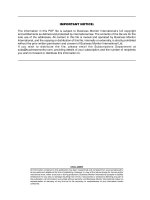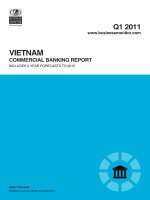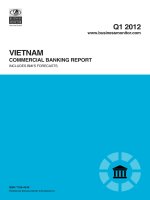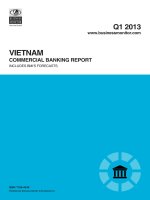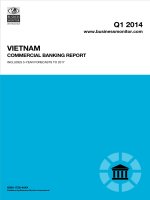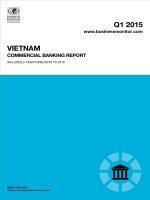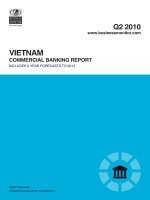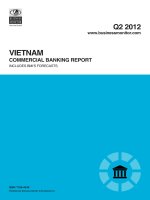Vietnam commercial banking report q2 2011
Bạn đang xem bản rút gọn của tài liệu. Xem và tải ngay bản đầy đủ của tài liệu tại đây (489.22 KB, 59 trang )
Q2 2011
www.businessmonitor.com
COMMERCIAL BANKING REPORT
ISSN 1758-454X
Published by Business Monitor International Ltd.
VIETNAM
INCLUDES BMI'S FORECASTS
Business Monitor International
Mermaid House,
2 Puddle Dock,
London, EC4V 3DS,
UK
Tel: +44 (0) 20 7248 0468
Fax: +44 (0) 20 7248 0467
Email:
Web:
© 2011 Business Monitor International.
All rights reserved.
All information contained in this publication is
copyrighted in the name of Business Monitor
International, and as such no part of this publication
may be reproduced, repackaged, redistributed, resold in
whole or in any part, or used in any form or by any
means graphic, electronic or mechanical, including
photocopying, recording, taping, or by information
storage or retrieval, or by any other means, without the
express written consent of the publisher.
DISCLAIMER
All information contained in this publication has been researched and compiled from sources believed to be accurate and reliable at the time of
publishing. However, in view of the natural scope for human and/or mechanical error, either at source or during production, Business Monitor
International accepts no liability whatsoever for any loss or damage resulting from errors, inaccuracies or omissions affecting any part of the
publication. All information is provided without warranty, and Business Monitor International makes no representation of warranty of any kind as
to the accuracy or completeness of any information hereto contained.
VIETNAM COMMERCIAL
BANKING REPORT Q2 2011
INCLUDING INDUSTRY FORECASTS TO 2015
Part of BMI’s Industry Report & Forecasts Series
Published by: Business Monitor International
Copy deadline: March 2011
Vietnam Commercial Banking Report Q2 2011
© Business Monitor International Ltd Page 2
Vietnam Commercial Banking Report Q2 2011
© Business Monitor International Ltd Page 3
CONTENTS
Executive Summary 5
Table: Levels (VNDbn) 5
Table: Levels (US$bn) 5
Table: Levels At August 2010 5
Table: Annual Growth Rate Projections 2011-2015 (%) 5
Table: Ranking Out Of 59 Countries Reviewed In 2011 6
Table: Projected Levels (VNDbn) 6
Table: Projected Levels (US$bn) 6
SWOT Analysis 7
Vietnam Commercial Banking SWOT 7
Vietnam Political SWOT 7
Vietnam Economic SWOT 8
Vietnam Business Environment SWOT 8
Business Environment Outlook 9
Commercial Banking Business Environment Ratings 9
Table: Vietnam’s Commercial Banking Business Environment Rating 9
Commercial Banking Business Environment Rating Methodology 9
Table: Asia Commercial Banking Business Environment Ratings 11
Global Commercial Banking Outlook 12
Regional Outlooks 12
Mergers And Acquisitions Outlook For Banks 16
Asia Banking Sector Outlook 18
Table: Banks’ Bond Portfolios, 2009 21
Tables: Asia Commercial Banking Business Environment Ratings 22
Tables: Comparison Of Loan/Deposit, Loan/Asset And Loan/GDP Ratios 23
Table: Anticipated Developments In 2011 24
Table: Comparison Of Total Assets, Client Loans And Client Deposits, 2009-2010 (US$bn) 25
Table: Comparison Of Per Capita Deposits, 2010 (US$) 26
Table: Interbank Rates And Bond Yields, 2010-2011 27
Vietnam Banking Sector Outlook 28
Economic Outlook 30
Table: Vietnam Economic Activity, 2008-2015 32
Company Profiles 33
Vietcombank 33
Table: Key Statistics For Vietcombank, 2004-2008 (VNDmn) 34
BIDV 35
Table: Key Statistics For BIDV, 2004-2006 (VNDmn) 36
VietinBank 37
Table: Key Statistics For VietinBank, 2005-2008 (VNDmn) 38
Agribank 39
Table: Balance Sheet (VNDmn, unless stated) 40
Table: Balance Sheet (US$mn, unless stated) 40
Vietnam Commercial Banking Report Q2 2011
© Business Monitor International Ltd Page 4
Table: Key Ratios (%) 40
MHB Bank 41
Table: Key Statistics For MHB Bank, 2006-2008 (VNDmn) 42
Habubank 43
Table: Key Statistics For Habubank, 2004-2007 (VNDmn) 44
Eximbank 45
Table: Balance Sheet (VNDmn, unless stated) 46
Table: Balance Sheet (US$mn, unless stated) 46
Table: Key Ratios (%) 46
Sacombank 47
Table: Stock Market Indicators 48
Table: Balance Sheet (VNDmn, unless stated) 48
Table: Balance Sheet (US$mn, unless stated) 49
Table: Key Ratios (%) 49
Saigonbank 50
Table: Stock Market Indicators 50
Table: Balance Sheet (VNDmn, unless stated) 51
Table: Balance Sheet (US$mn, unless stated) 51
Table: Key Ratios (%) 51
SeABank 52
Table: Balance Sheet (VNDmn, unless stated) 53
Table: Balance Sheet (US$mn, unless stated) 53
Table: Key Ratios (%) 53
BMI Banking Sector Methodology 54
Commercial Bank Business Environment Rating 55
Table: Commercial Banking Business Environment Indicators And Rationale 56
Table: Weighting Of Indicators 57
Vietnam Commercial Banking Report Q2 2011
© Business Monitor International Ltd Page 5
Executive Summary
Table: Levels (VNDbn)
Date
Total assets
Client loans
Bond
portfolio
Other
Liabilities &
capital
Capital
Client
deposits
Other
August 2009
2,065,761.6
1,706,340.0
173,358.3
186,063.3
2,065,761.6
286,547.0
1,594,992.6
184,222.0
August 2010
2,624,434.1
2,191,880.0
203,131.1
229,423.0
2,624,434.1
360,566.0
2,038,758.6
225,109.5
Change, % 27%
28%
17%
23%
27%
26%
28%
22%
Source: BMI, SBV
Table: Levels (US$bn)
Date
Total assets
Client loans
Bond
portfolio
Other
Liabilities
&
capital
Capital
Client
deposits
Other
August 2009 115.9
95.7
9.7
10.4
115.9
16.1
89.5
10.3
August 2010 134.7
112.5
10.4
11.8
134.7
18.5
104.6
11.5
Change, % 16%
17%
7%
13%
16%
15%
17%
12%
Source: BMI, SBV
Table: Levels At August 2010
Loan/deposit ratio Loan/asset ratio
Loan/GDP ratio
GDP per capita,
US$
Deposits per
capita, US$
107.51% 83.52%
118.16%
1,063
1,189
Falling Rising
Rising
Source: BMI, SBV
Table: Annual Growth Rate Projections 2011-2015 (%)
Assets
Loans
Deposits
Annual Growth Rate 20
20
15
CAGR 20
20
14
Ranking 2
3
14
Source: BMI
Vietnam Commercial Banking Report Q2 2011
© Business Monitor International Ltd Page 6
Table: Ranking Out Of 59 Countries Reviewed In 2011
Loan/deposit ratio Loan/asset ratio
Loan/GDP ratio
5 2
10
Local currency asset growth
Local currency loan growth
Local currency deposit growth
5 3
13
Source: BMI
Table: Projected Levels (VNDbn)
2007
2008
2009
2010e 2011f 2012f 2013f 2014f 2015f
Total assets
1,410,221 1,747,335 2,411,323 2,893,587 3,472,305 4,166,766 5,000,119 6,000,143 7,200,171
Client loans
1,067,730 1,339,260 1,848,179 2,217,815 2,661,377 3,193,653 3,832,384 4,598,860 5,518,632
Client deposits
1,100,393 1,341,143 1,528,903 1,697,082 1,917,703 2,186,181 2,492,247 2,841,161 3,267,335
e/f = BMI estimate/forecast. Source: BMI, SBV
Table: Projected Levels (US$bn)
2007
2008
2009
2010e 2011f 2012f 2013f 2014f 2015f
Total assets 88.05
99.94
130.56
148.40
173.62
208.34
256.42
315.80
389.20
Client loans 66.66
76.60
100.07
113.75
133.07
159.68
196.53
242.05
298.30
Client deposits 68.70
76.71
82.78
87.04
95.89
109.31
127.81
149.53
176.61
e/f = BMI estimate/forecast. Source: BMI, SBV
Vietnam Commercial Banking Report Q2 2011
© Business Monitor International Ltd Page 7
SWOT Analysis
Vietnam Commercial Banking SWOT
Strengths
Rapid growth and untapped potential.
High savings rate of Vietnamese consumers.
Increasingly open to foreign banks since WTO accession in 2007.
The role of state-owned banks is steadily decreasing.
Weaknesses
Vietnamese banks lack the capital and technology to sustain high credit growth.
The financial accounts of many banks are still opaque.
High exposure to real estate and stock market loans among smaller banks.
Opportunities
The population is under-banked.
Income levels are likely to rise strongly over the medium term.
Threats
Macroeconomic instabilities threaten the credibility of the government and could
potentially drive economic policy away from further liberalisation.
Vietnam Political SWOT
Strengths
The Communist Party government appears committed to market-oriented reform. The
one-party system is generally conducive to short-term political stability.
Relations with the US are generally improving, and Washington regards Hanoi as a
potential geopolitical ally in South East Asia.
Weaknesses
Corruption among officials poses a major threat to the legitimacy of the party.
There is increasing, albeit still limited, public dissatisfaction with the leadership’s tight
control over political dissent.
Opportunities
The government recognises the threat that corruption poses to its legitimacy and has
acted to clamp down on graft among party officials.
Vietnam has allowed legislators to become more vocal in criticising government
policies. This is opening up opportunities for more checks and balances in the one-
party system.
Threats
The slowdown in growth in recent years is likely to weigh on public acceptance of the
one-party system. Demonstrations against economic conditions could develop into a
full-on challenge to undemocratic rule.
Although strong domestic control will ensure little change to Vietnam’s political scene
in the next few years, over the longer term the one-party system will probably be
unsustainable.
Relations with China have deteriorated in recent years due to Beijing’s more assertive
stance over disputed islands in the South China Sea and criticism of a large Chinese
investment into a bauxite mining project in the central highlands, which could
potentially cause widespread environmental damage.
Vietnam Commercial Banking Report Q2 2011
© Business Monitor International Ltd Page 8
Vietnam Economic SWOT
Strengths
Vietnam was one of the fastest growing economies in Asia in the 2000s, with GDP
growth averaging 7.6% annually between 2000 and 2007.
The economic boom lifted many Vietnamese people out of poverty, with the official
poverty rate in the country falling from 58% in 1993 to 20% in 2004.
Weaknesses
Vietnam still suffers from substantial trade, current account and fiscal deficits, leaving
the economy vulnerable. The fiscal picture is clouded by considerable ‘off the books’
spending.
The heavily managed and weak Vietnamese dong reduces incentives to improve the
quality of exports and it also keeps import costs high, contributing to inflationary
pressures.
Opportunities
WTO membership has given Vietnam access to foreign markets and capital and
makes Vietnamese enterprises stronger through increased competition.
The government will move forward with market reforms, including privatisation of
state-owned enterprises and liberalising the banking sector.
Urbanisation will continue to be a long-term growth driver. The UN forecasts the
urban population to rise from 29% of the total to more than 50% by the early 2040s.
Threats
Inflation and deficit concerns have led some investors to reassess their hitherto
upbeat view of Vietnam. If the government focuses too much on stimulating growth
and fails to root out inflationary pressure, it risks prolonging macroeconomic
instability, which could lead to a potential crisis.
Prolonged macroeconomic instability could prompt the authorities to put reforms on
hold as they struggle to stabilise the economy.
Vietnam Business Environment SWOT
Strengths
Vietnam has a large, skilled and low-cost workforce that has made the country
attractive to foreign investors.
Vietnam’s proximity to China and South East Asia, plus its good sea links, make it a
good base for foreign companies to export to the rest of Asia and beyond.
Weaknesses
Vietnam’s infrastructure is still weak. Roads, railways and ports are inadequate to
cope with the country’s economic growth and links with the outside world.
Vietnam remains one of the world’s most corrupt countries. Its score in Transparency
International’s 2010 Corruption Perceptions Index was 2.7, placing it in 22
nd
place in
the Asia Pacific region and 116
th
(out of 178) overall.
Opportunities
Vietnam is increasingly attracting investment from key Asian economies such as
Japan, South Korea and Taiwan. This offers the possibility of the transfer of high-tech
skills and knowhow.
Vietnam is pressing ahead with the privatisation of state-owned enterprises and the
liberalisation of the banking sector. This should offer foreign investors new entry
points.
Threats
Trade disputes with the US and the general threat of American protectionism will
remain concerns.
Labour unrest is a lingering threat. Failure by the authorities to boost skills levels
could leave Vietnam as a second-rate economy for an indefinite period.
Vietnam Commercial Banking Report Q2 2011
© Business Monitor International Ltd Page 9
Business Environment Outlook
Commercial Banking Business Environment Ratings
Table: Vietnam’s Commercial Banking Business Environment Rating
Limits of Potential Returns Data
Score, out of
10
Ratings score, out of
100
Total assets, 2010 US$148.4mn 6 Market Structure 67
Growth in total assets, 2011-2015 7
Growth in client loans, 2011-2015 7
GDP per capita, 2010 US$1,153 2 Country Structure 53
Tax 2.9 3
GDP volatility 0.4 10
Financial infrastructure 5.6 6
Risks to Realisation of Returns
Regulatory framework and development 4.5 5 Market Risk 40
Regulatory framework and competitive landscape 5.0 5
Moody’s rating for local currency deposits 2.0 2
Long-term financial risk 4.8 5 Country Risk 46
Long-term external risk 3.3 3
Long-term policy continuity 7.0 7
Legal framework 3.7 4
Bureaucracy 3.9 4
Commercial Banking Business Environment Rating 56
Source: BMI
Commercial Banking Business Environment Rating Methodology
Since Q108, we have described numerically the banking business environment for each of the countries
surveyed by BMI. We do this through our Commercial Banking Business Environment Rating (CBBER),
a measure that ensures we capture the latest quantitative information available. It also ensures consistency
across all countries and between the inputs to the CBBER and the Insurance Business Environment
Rating, which is likewise now a feature of our insurance reports. Like the Business Environment Ratings
calculated by BMI for all the other industries on which it reports, the CBBER takes into account the
limits of potential returns and the risks to the realisation of those returns. It is weighted 70% to the former
and 30% to the latter.
Vietnam Commercial Banking Report Q2 2011
© Business Monitor International Ltd Page 10
The evaluation of the Limits of Potential Returns includes market elements that are specific to the
banking industry of the country in question and elements that relate to that country in general. Within the
70% of the CBBER that takes into account the Limits of Potential Returns, the market elements have a
60% weighting and the country elements have a 40% weighting. The evaluation of the Risks to
Realisation of Returns also includes banking elements and country elements (specifically, BMI’s
assessment of long-term country risk). However, within the 30% of the CBBER that takes into account
the risks, these elements are weighted 40% and 60% respectively.
Further details on how we calculate the CBBER are provided at the end of this report. In general, though,
three aspects need to be borne in mind in interpreting the CBBERs. The first is that the market elements
of the Limits of Potential Returns are by far the most heavily weighted of the four elements. They account
for 60% of 70% (or 42%) of the overall CBBER. Second, if the market elements are significantly higher
than the country elements of the Limits of Potential Returns, it usually implies that the banking sector is
(very) large and/or developed relative to the general wealth, stability and financial infrastructure in the
country. Conversely, if the market elements are significantly lower than the country elements, it usually
means that the banking sector is small and/or underdeveloped relative to the general wealth, stability and
financial infrastructure in the country. Third, within the Risks to Realisation of Returns category, the
market elements (ie: how regulations affect the development of the sector, how regulations affect
competition within it, and Moody’s Investors Service’s ratings for local currency deposits) can be
markedly different from BMI’s long-term risk rating.
Vietnam Commercial Banking Report Q2 2011
© Business Monitor International Ltd Page 11
Table: Asia Commercial Banking Business Environment Ratings
Limits of Potential
Returns
Risks to Potential
Returns Overall
Market
Structure
Country
Structure
Market
Risks
Country
Risks
Rating
Ranking
Bangladesh 43.3
45.0
30.0
42.0
42.0
54
China 93.3
55.0
56.7
76.0
75.1
13
Hong Kong 73.3
92.5
70.0
84.0
80.2
9
India 83.3
55.0
53.3
54.0
66.5
24
Indonesia 73.3
62.5
76.7
42.0
65.1
29
Japan 33.3
77.5
63.3
80.0
57.7
38
Malaysia 70.0
80.0
76.7
80.0
75.4
12
Pakistan 40.0
50.0
56.7
36.0
44.1
52
Philippines 50.0
62.5
56.7
52.0
54.7
42
Singapore 70.0
95.0
96.7
86.0
83.1
6
Sri Lanka 23.3
55.0
36.7
44.0
37.5
56
South Korea 80.0
85.0
76.7
70.0
79.2
10
Taiwan 76.7
72.5
83.3
74.0
75.8
11
Thailand 56.7
65.0
80.0
68.0
63.8
31
Vietnam 66.7
52.5
40.0
46.0
55.8
40
US 90.0
85.0
100.0
76.0
87.3
2
Scores out of 100, with 100 the highest. Source: BMI
Vietnam Commercial Banking Report Q2 2011
© Business Monitor International Ltd Page 12
Global Commercial Banking Outlook
In line with our core view, the financial sector’s recovery has been slow across most of the world, with
asset and loan growth in the US and Western Europe still lagging the generally robust expansion in
emerging markets. Still, with the global economy picking up momentum, commercial banking sectors
around the world are increasingly on solid ground. After looking at how the recovery is proceeding across
regions, we examine the potential for mergers and acquisitions within the global commercial banking
sector in 2011.
Regional Outlooks
Developed states: With the US economy improving, the signs for renewed asset and loan growth in the
US commercial banking sector are increasingly positive, and we see upside risks to our forecasts in 2011
and 2012. Continued falls in delinquency rates should continue to fuel the appetite to lend, though real
estate financing will probably remain subdued for some quarters yet. With unemployment remaining
high, the household deleveraging process still has some room to run.
The Worst May Be Over
US – Delinquency Rates By Type Of Loan, %
Source: US Federal Reserve
Meanwhile, confidence in the eurozone banking sector has continued to improve, with conditions in the
interbank and corporate lending markets showing further stabilisation since the height of the sovereign
financial crisis in mid-2010. There are headwinds, however. The fragility of Spain’s savings banks, or
Cajas, continues to drive market concern over the broader health of the banking sector. The onset of
major fiscal austerity in 2011 is also expected to take its toll. However, while crisis risks in the periphery
Vietnam Commercial Banking Report Q2 2011
© Business Monitor International Ltd Page 13
have abated following Ireland’s EU bailout in late November, the European Central Bank (ECB) remains
cautious over the dependence of troubled banks on its special liquidity facility, and may seek a
normalisation of policy sooner rather than later.
Subdued Growth Ahead
Europe – Banking Sector Asset Growth, %
Source: BMI, central banks
Latin America: Rampant loan growth in 2010, combined with massive foreign capital inflows, has
increased the risk of a rapid deterioration in loan quality for Latin America’s commercial banking sector,
which would both hurt investor confidence and have negative implications for regional growth.
Nevertheless, we see three mitigating factors which make us believe the region’s banks will avoid such a
crisis the implication being the sector will continue to act as a source of stability and growth over the
coming years. First, credit growth is strongest in economies where the growth outlook is strongest.
Second, fiscal buffers are adequate to prevent a rapid loss of investor confidence in the sector. Third,
banks themselves have sufficient capital and profit margins to weather a spike in non-performing loans
(NPLs), with each of the major players exceeding the 7.0% total capital coverage requirement recently set
out in the Basel III Accords.
Vietnam Commercial Banking Report Q2 2011
© Business Monitor International Ltd Page 14
Brazil Stands Out
Latin America – Commercial Banking Sector Loan-to-Deposit Ratios
Source: BMI, BCB, SBIF, SBS, SFC
Asia: After a strong year in 2010, Asia’s banking sector remains sound going into 2011. On balance, we
prefer markets with strong domestic consumer demand (leading to higher credit growth and with less
downside risks from external factors), low loan-to-deposit ratios (allowing comfortable expansion of
credit without adding stress to the financial system) and less exposure to risks posed by surging capital
inflows. We have identified India and Indonesia to be in relatively sanguine positions with strong growth
potential going into 2011. Amongst the markets we do not like, we flag up Australia and Vietnam which
potentially face systemic risks.
Emerging Europe: We are cautiously optimistic on the broad outlook for the banking sector in Emerging
Europe, which stands to benefit from a cyclical pickup in economic growth across the region. Robust
economic growth in countries such as Poland and Russia will lead to more favourable operating
conditions for Emerging European banks, spurring credit demand and improving existing credit quality.
Even banks present in those countries that face more challenging environments, such as Romania and
Hungary, should see improved performance as a more favourable economic backdrop provides a boon.
Vietnam Commercial Banking Report Q2 2011
© Business Monitor International Ltd Page 15
Lending To Pick Up In Poland & Russia
Emerging Europe – Banking Sector Credit By Country, % change y-o-y
Source: BMI, central banks
Middle East And Africa: Sub-Saharan Africa (SSA)’s major banking sectors are all continuing their
recoveries, albeit with varying degrees of success. Recent data for the the Kenyan and South African
banking sectors are encouraging. However, the picture is less rosy for the Nigerian banking sector, which
continues to tread between crisis and recovery. Looking ahead, we expect the recovery to continue for all
of SSA’s major banking sectors throughout 2011. In the Middle East, we remain concerned about the
prospects for the domestic banking sector in the United Arab Emirates over the coming quarters, as
ongoing loan loss provisioning and weak demand for new credit weighs heavily on asset expansion and
profitability in 2011. In Saudi Arabia, credit growth remains subdued.
Nigeria Still Concerning
Africa – Total Asset Growth, % change y-o-y
Source: SARB, CBN, CBK
Vietnam Commercial Banking Report Q2 2011
© Business Monitor International Ltd Page 16
Mergers And Acquisitions Outlook For Banks
With the global financial market and economic recovery picking up in earnest, our Corporate Financing
Week team has been looking into the prospects for consolidation and expansion within the commercial
banking sector in 2011. We see interesting trends in emerging markets as the internationalisation of retail
and investment banking continues.
Western banks need more capital: Spain’s caja savings banks are desperately in need of fresh capital to
avoid state ownership, while even Britain’s part-nationalised banks are likely to need more funds as new
regulations are put into place. The UK’s Independent Commission on Banking has signalled that it will
not recommend that the industry splits up into consumer and investment banks, but it remains likely that
its Chairman, former Bank of England economist and Oxford University professor, John Vickers will
favour the ring-fencing of the investment and consumer banking units. This will likely raise capital
requirements for banks and increase their fundraising costs, as the likelihood of a government bailout on
favourable terms for investment banking units would be slim. When taken together with the existing need
for new capital, we expect to see many more individual units, both domestic and international, up for sale.
Barclays, which escaped the worst ravages of the credit crunch, is looking to sell its commercial
mortgage unit Barclays Capital Mortgage Servicing Limited.
European relistings may be some way off: Although the US government has been relatively quick off
the mark in selling off the stakes it acquired during the credit crunch, including holdings in Citigroup and
automaker GM, European governments have lagged behind. We are not expecting a major acceleration in
the process in either the UK or continental Europe, with one of the few indicative dates being the Dutch
finance ministry’s preference to exit the financial sector over the next five years, with ABN AMRO’s
listing likely to be no earlier than 2013. A similar timescale is likely to play out in the UK.
Most exciting M&A activity likely to be in emerging markets: Although no emerging market deal is
going to match the blockbuster nature of developed market relistings, many of the most exciting deals are
going to involve EM companies in one way or another. We are still seeing developed-market companies
prowling EMs to add assets to their portfolios in higher growth markets – Standard Chartered has
bought the Singapore operations of auto and personal loan specialist GE Money – and expect further
deals as the more solvent western institutions attempt to ‘buy’ their way out of slow growth at home. This
trend is going to play out at the same time as EM institutions are becoming more acquisitive themselves.
Russia’s market leader Sberbank is on the acquisition trail both at home and abroad, with plans to enter
investment banking through the purchase of Troika Dialog, and has signalled that it is looking at targets
elsewhere in emerging Europe. This is partially about finding new growth sectors, but also about buying
expertise, a path a number of Chinese banks are going to tread over the coming years. Industrial and
Commercial Bank of China (ICBC) has become the country’s first bank to buy a stake in a US retail
Vietnam Commercial Banking Report Q2 2011
© Business Monitor International Ltd Page 17
bank following its purchase of 80% of Bank of East Asia’s US unit. The deal will gives ICBC 10
branches in California and three in New York.
EM markets will slowly liberalise: The financial crisis and subsequent heavy intervention of Western
governments in their financial markets has slowed down the pace of liberalisation in emerging markets.
We expect to see a gradual opening up of local banking sectors, as governments slowly divest their
remaining financial holdings. Some of these moves are going to be out of necessity, such as Russia’s
plans to raise US$32bn through the divestiture of state holdings including stakes in Sberbank and smaller
rival VTB, but we believe the emerging world is on course to open up further.
Vietnam Commercial Banking Report Q2 2011
© Business Monitor International Ltd Page 18
Asia Banking Sector Outlook
Strong Outlook, But Watch Out For Bubble Risks
Banks in the Asia Pacific region are generally well-positioned in 2011, and we believe that loan growth
potential is highest in Indonesia and India. On the downside, surging capital inflows have led to a sharp
spike in asset prices. We believe that a disorderly unwinding of assets (especially property) poses the
largest risk to banks in the region.
After a strong year in 2010, Asia’s banking sector remains sound. On balance, we prefer markets with
strong domestic consumer demand (leading to higher credit growth and with less downside risks from
external factors), low loan-to-deposit ratios (LDRs, to allow comfortable expansion of credit without
adding stress to the financial system) and less exposure to risks posed by surging capital inflows. We
have identified India and Indonesia to be in a relatively sanguine position with strong growth potential.
Amongst the markets we do not like, we flag up Australia and Vietnam to potentially face systemic risks.
Bullish On Domestic
Demand Plays
Asia Pacific – Real GDP Growth Forecasts For 2011, %
Source: BMI
Identifying Growth Potential
In order to assess credit growth potential, we have to examine the economies that we are more bullish on
over the medium term. Unsurprisingly, India, China and Indonesia lead the pack in our forecast for real
GDP growth, projected to reach 8.1%, 7.5% (with upside risks) and 5.9% respectively in 2011. For India
and Indonesia, we like the consumer story over the longer term and also believe that investment growth
will remain robust, both of which are highly positive for credit growth. However, in the case of China, we
Vietnam Commercial Banking Report Q2 2011
© Business Monitor International Ltd Page 19
are more downbeat on its investment outlook even as we expect consumer spending to be relatively
robust. Indeed, there are clear signs that the Chinese authorities may be targeting a lower loan growth rate
for 2011 as they battle with inflationary pressures. As such, we believe that investment loans (especially
in the property sector) may be held back in the coming quarters. Accordingly, we are expecting loan
growth in China to underperform, reaching just 8.0%, compared to India (18.0%) and Indonesia (20.0%).
Within the region, Australia and Japan stand out as two economies with weak growth potential in 2011, at
2.4% and 0.7% respectively. In Australia’s case, we believe that the economy will be hit by a correction
in real estate prices. Regarding Japan, recent indicators all point to an economic slowdown (possibly even
a technical recession) in the coming quarters. Indeed, the most recent Tankan Survey report indicated
increased pessimism in Japanese firms and this trend has been reflected in the average monthly year-on-
year (y-o-y) contraction of 2.2% in the loan growth rate from April to October. Accordingly, we are
projecting loan growth to remain flat in Japan and to register a contraction of 1.3% in Australia in 2011.
Strik
ing A Good Balance
Asia Pacific – Loan-to-deposit Ratio and Loan Growth Projection For 2011
Source: Respective Central Banks, BMI
Low Leverage In Financial System
Since the Asian Financial Crisis in 1997/98, banks in the region have generally been prudent and avoided
stacking on excessive leverage. Indeed, by our calculation, the average LDR for the Asia-Pacific region is
around 84%, a very low figure compared to their European (110%), Middle Eastern (94%) and Latin
American counterparts (91%). Accordingly, this implies that banks in the Asia-Pacific region will have
more leeway to embark on more aggressive lending. Notably, the two domestic-demand plays that we
favour in 2011 (India and Indonesia) both have LDRs below 80%.
Vietnam Commercial Banking Report Q2 2011
© Business Monitor International Ltd Page 20
Meanwhile, we are growing increasingly worried about Vietnam’s very high LDR and caution that asset
deterioration may pose a serious systemic problem. According to our estimates, Vietnam’s LDR may
reach 130% (a very high level even for developed states) in December 2010, compared to a more
reasonable level of 100% in 2008. We believe that the mind-boggling levels of loan growth seen in 2009
(38%) and 2010 (estimated to be around 20%) cannot be sustained, especially if banks continue to have
problems attracting deposits. In the event of a liquidity shortage or insolvency triggered by economic
stress, a financial crisis would be a plausible scenario.
Vulnerable To Property Pr
ice Correction
Asia Pacific – Banking Exposure To Property, % of total loans
Source: BMI, central banks
Surging Asset Prices A Key Risk
A prolonged period of easy monetary conditions in the developed world since the height of the global
financial crisis in Q109 has led to a wall of funds flowing from the US and the eurozone into Asia. While
these fund flows have not proven to be destabilising for the Asian financial markets yet, some worrying
symptoms have emerged. These include surging asset prices and rising consumer price inflation. Should
foreign investors embark on a disorderly unwind of positions in Asia, stress resulting from foreign
exchange fluctuations and declining property prices would be placed on the balance sheets of Asian
banks. In the current situation we believe that currency volatility is less of an issue, whereas a crash in
property prices is a key concern. Indeed, for Indonesia, Thailand and South Korea (the three economies
whose currencies were worst hit in 1997/98), the authorities have already stepped up capital controls to
prevent excessive speculation. Coupled with the rapid reserve buildup over the last few months (total
foreign reserves for the three countries are up by 51.7% since January 2009 to reach US$551.2bn in
November 2010), we believe that there is considerable cushion to prevent any currency rout in the event
of a sustained investor selloff.
Vietnam Commercial Banking Report Q2 2011
© Business Monitor International Ltd Page 21
Property prices will prove trickier to handle. A collapse in real estate prices will impact on the banks’
loan portfolio and overall profitability will consequently be hit amid a rise in non-performing loans.
Anecdotal evidence and official data in several Asian economies including China, Singapore, Hong Kong
and South Korea suggest that prices are close to or have already pushed past their pre-crisis peak.
Although we note that authorities in these three regions have already taken accretive steps towards
stemming property price increases, it will prove difficult to strike a balance in fear that anti-speculative
measures may be too harsh.
By our estimates, banking sector exposure to property is very high in economies such as Australia,
Singapore and Hong Kong. In our view, Australian banks, which have over 60% of their loan portfolio
related to the property sector, are the most vulnerable to a sudden correction in either its currency or the
property market.
Table: Banks’ Bond Portfolios, 2009
Bond Portfolio, US$bn Bonds, % total assets Year-on-Year Growth, %
Bangladesh 15.6
26.0
19.4
China 1,358.8
11.5
24.9
Hong Kong 303.8
22.1
29.1
India 236.7
24.0
20.6
Indonesia 14.4
5.5
18.5
Japan 2,269.5
26.5
12.4
Malaysia 52.6
13.2
18.1
Pakistan 22.2
27.9
8.0
Philippines 31.9
27.0
12.8
Singapore 67.9
13.4
36.2
Sri Lanka 2.2
12.8
18.2
South Korea 225.7
15.6
-7.1
Taiwan 125.4
12.8
31.2
Thailand 50.7
16.3
22.4
Vietnam 8.6
6.6
-11.6
US 2,500.5
19.1
22.8
Source: Central banks, regulators, BMI
Vietnam Commercial Banking Report Q2 2011
© Business Monitor International Ltd Page 22
Tables: Asia Commercial Banking Business Environment Ratings
Limits of Potential
Returns Risks to Potential Returns Overall
Market
Structure
Country
Structure
Market
Risks
Country
Risks
Rating
Ranking
Bangladesh 43.3
45.0
30.0
42.0
42.0
54
China 93.3
55.0
56.7
76.0
75.1
13
Hong Kong 73.3
92.5
70.0
84.0
80.2
9
India 83.3
55.0
53.3
54.0
66.5
24
Indonesia 73.3
62.5
76.7
42.0
65.1
29
Japan 33.3
77.5
63.3
80.0
57.7
38
Malaysia 70.0
80.0
76.7
80.0
75.4
12
Pakistan 40.0
50.0
56.7
36.0
44.1
52
Philippines 50.0
62.5
56.7
52.0
54.7
42
Singapore 70.0
95.0
96.7
86.0
83.1
6
Sri Lanka 23.3
55.0
36.7
44.0
37.5
56
South Korea 80.0
85.0
76.7
70.0
79.2
10
Taiwan 76.7
72.5
83.3
74.0
75.8
11
Thailand 56.7
65.0
80.0
68.0
63.8
31
Vietnam 66.7
52.5
40.0
46.0
55.8
40
US 90.0
85.0
100.0
76.0
87.3
2
Scores out of 100, with 100 the highest. Source: BMI
Vietnam Commercial Banking Report Q2 2011
© Business Monitor International Ltd Page 23
Tables: Comparison Of Loan/Deposit, Loan/Asset And Loan/GDP Ratios
Loan/
Deposit
Ratio,
% Rank Trend
Loan/
Asset
Ratio,
% Rank Trend
Loan/
GDP
Ratio,
% Rank Trend
Bangladesh 78.7
43
Rising
64.7
15
Falling
45.8
43
Rising
China 69.5
51
Rising
52.6
37
Rising
126.6
8
Rising
Hong Kong 54.1
57
Falling
31.4
57
Rising
194.2
3
Falling
India 78.2
45
Falling
64.5
10
Rising
47.5
42
Rising
Indonesia 76.7
40
Rising
59.4
27
Rising
28.3
51
Rising
Japan 71.3
50
Falling
51.3
39
Falling
86.4
20
Rising
Malaysia 79.3
41
Rising
59.6
23
Rising
119.4
7
Rising
Pakistan 63.0
49
Falling
47.6
41
Falling
22.0
55
Falling
Philippines 67.2
53
Falling
49.1
42
Falling
32.2
50
Falling
Singapore 73.8
47
Falling
40.2
52
Falling
106.0
14
Rising
Sri Lanka 68.0
54
Falling
53.6
38
Falling
23.7
56
Falling
South Korea 122.1
13
Falling
69.5
6
Rising
111.3
13
Falling
Taiwan 77.7
46
Falling
61.0
26
Falling
143.1
6
Falling
Thailand 95.8
27
Falling
64.7
16
Falling
68.7
30
Falling
Vietnam 130.7
5
Rising
76.6
2
Falling
113.5
10
Rising
US 79.3
42
Falling
56.1
33
Falling
50.9
39
Falling
Source: Central banks, regulators, BMI
Vietnam Commercial Banking Report Q2 2011
© Business Monitor International Ltd Page 24
Table: Anticipated Developments In 2011
Loan/Deposit
Ratio, % Trend
Loan Growth,
US$bn
Deposit
Growth, US$bn
Residual,
US$bn
Bangladesh 78.7
Falling
7.5
9.6
-2.0
China 69.5
Falling
692.8
996.3
-303.5
Hong Kong 55.7
Rising
22.1
16.3
5.8
India 77.5
Falling
78.8
110.0
-31.3
Indonesia 79.5
Rising
26.8
20.7
6.1
Japan 70.3
Falling
-455.6
-540.2
84.5
Malaysia 80.5
Rising
39.2
43.4
-4.3
Pakistan 72.7
Rising
9.4
2.9
6.5
Philippines 67.5
Rising
8.1
11.6
-3.4
Singapore 75.8
Rising
24.5
26.0
-1.5
Sri Lanka 66.8
Falling
1.8
2.9
-1.2
South Korea 117.3
Falling
-0.2
37.3
-37.5
Taiwan 75.0
Rising
10.9
46.1
-35.2
Thailand 93.5
Falling
12.6
19.2
-6.7
Vietnam 138.8
Rising
19.3
8.8
10.5
US 80.5
Rising
298.6
235.3
63.3
Note: Incorporates estimated economic data and projected banking data. Source: Central banks, regulators, BMI
